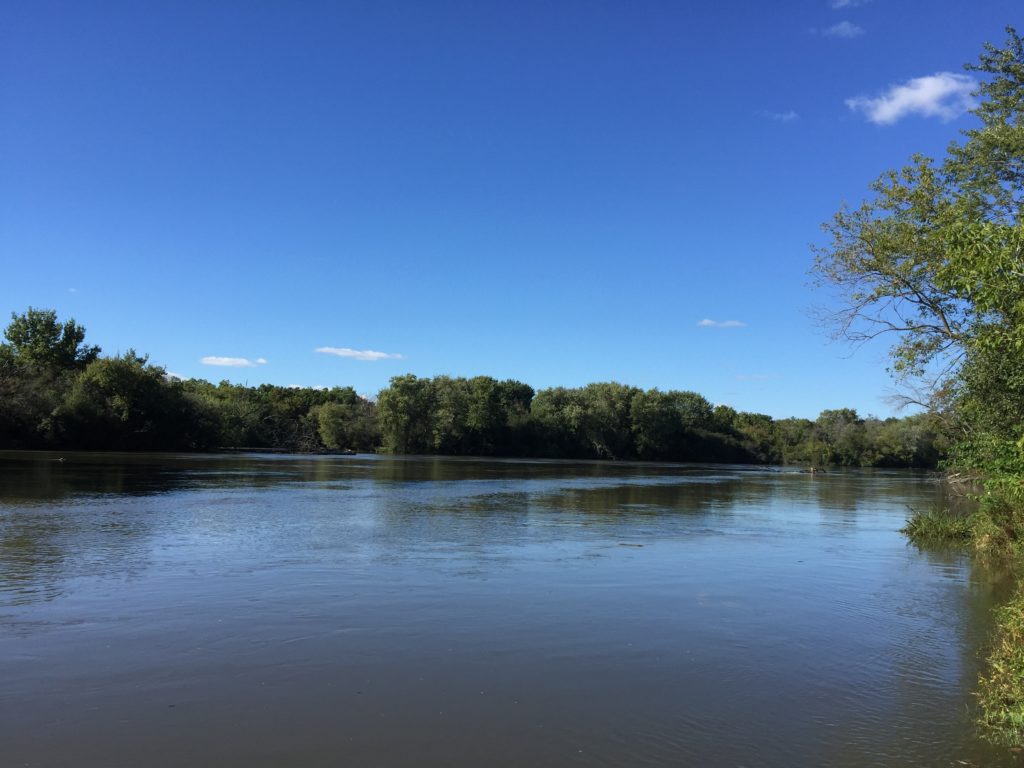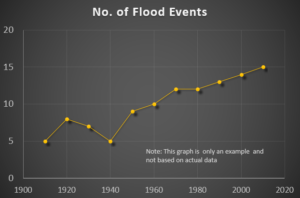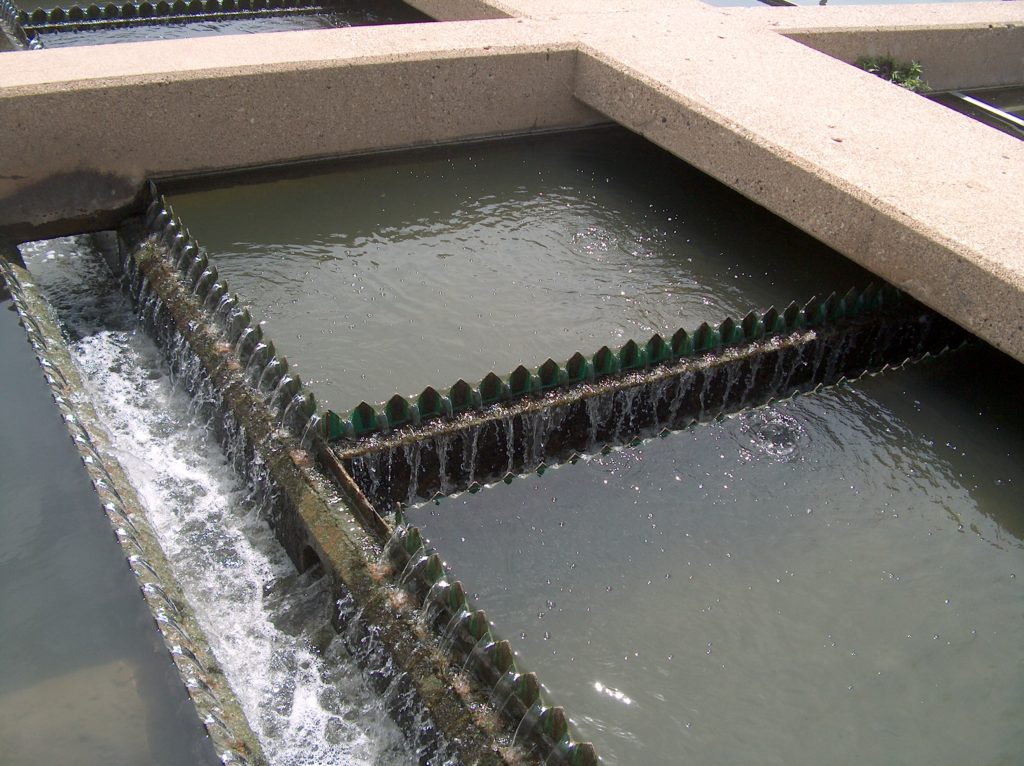
Lately I’ve seen several presentations which all include a similar slide with a graph like the generic one I created below. All the presenters then refer to the graph on the slide and make a statement similar to this: “and because of climate change you can see an increase in flooding over the last several decades.” But with no supporting data ever offered to attribute this trend to climate change, these graphs have instead made me think the cause is most likely sewage.

So how do I get sewage out of this? Well, first it helps to have a background in the history of water distribution and wastewater treatment in the U.S. While some major cities began piping water to homes in the 1800s, construction of water distribution systems didn’t began in most areas until the early 1900s. At this time, wastewater in most areas was still discharged without central collection or treatment. According to Urban Wastewater Management
in the United States:Â Past, Present, and Future, “By 1905, more than 95 percent of the urban population discharged their wastewater untreated to waterways. Little changed over the first quarter of the twentieth century,
and in 1924 more than 88 percent of the population in cities of over
100,000 continued to dispose of their wastewater directly to waterways.” Because this led to a non-centralized system, sewage was sometimes sent directly to a stream from multiple outlets and sometimes dispersed over land to eventually make its way to a stream.
All this began to change in the mid-1900s. The same publication cited above also noted Congress enacted “the Water Pollution Control Act of 1948. The legislation provided for comprehensive planning, technical services, research, financial assistance, and enforcement. The Water Pollution Control Act was extended in 1952 and became permanent legislation in 1956.” There was a 1965 amendment to this act, and then eventually in 1972, Congress passed another Water Pollution Control Act.  The paper points out “the 1972 Act set the unprecedented goal of eliminating all water pollution by 1985 and authorized expenditures of $24.6 billion in research and construction grants.”
The result of this flurry of legislative activity between 1948 and 1972 resulted in the installation of centralized wastewater treatment systems in urban areas across the U.S. Today all discharges from each of these systems are regulated through permits from the USEPA primarily for water quality control. The discharges are typically introduced to a stream or other body of water directly from the treatment plant. Treatment discharges have the potential to range from less than 1 million gallons per day (MGD) to 1.44 billion gallons per day. That’s a lot of water entering our streams on a continuous basis which is why I immediately thought of wastewater as a cause when I saw the graph trending up after the mid 1900s.

Another reason I suspected wastewater had a major impact on stream flow was based on something I heard regarding the river flowing through our city. It seems in the past, people could walk across the river in the summer. As you can see in the photo of this river which I included at the start of this article, walking across the river today would most likely never be possible. In hearing this, there was no question in my mind that this was due to the wastewater discharges which now regularly flow into our river and increase its base flow.
So during the last presentation I attended, I asked if impacts from wastewater discharges were considered or analyzed to see how much these flows are contributing to increased flooding. I explained if prior to installation of wastewater treatment plants, base flows of rivers could reduce to almost nothing, these streams would have had more capacity to handle rainfall events. But now with increased base flow due to wastewater discharges, which really started entering streams between 1948 and the 1980s and continue to do so and increase, the ability of streams to handle rainfall events has decreased. This could be a cause of rainfall events impacting greater areas and resulting in increased damages in suburban areas. Also, as this USGS site shows, How Much Water Do We Use?, public water supply usage has increased over the years which would increase wastewater discharges even more. The presenter said they had never looked at the impacts of wastewater discharges.
As I continued to wonder about this, I looked online to see if others had thought of the impact of wastewater discharges on flooding events and discovered yes, they have. I even found studies which were done on the river in my community. H. Vernon Knapp, senior hydrologist with the Illinois State Water Survey, has developed at least two studies for the Fox River in Illinois which related to this topic. In his paper, the “Fox River Basin Streamflow Assessment Model: Hydrologic Analysis, October 1988,” he analyzes the river flow taking into consideration impacts from effluent discharges from wastewater plants along the river. According to Knapp, in 1988, “approximately half of the low flows in the river upstream of these plants originated as effluent discharges from other facilities. Under these circumstances, the capacity of the Fox River to assimilate the additional effluents should be of concern.” His paper is also informative regarding other factors which can impact stream flow.
More recently Knapp developed a presentation, Effects of Future Water Demands and Climate Change on Fox River Water Availability. In it he states “watershed modeling suggests that the potential effect of climate change on Fox River low flows is considerably less than the effects of effluents and withdrawals, and thus does not substantially alter the water supply potential of the river.” He also notes “low flows in rivers such as the DesPlaines are almost 100% effluent.”
Perhaps not all increased flooding in all watersheds can be directly attributable to increased wastewater discharges since the 1940s, but I’m surprised it’s not always at least considered. Instead increased flooding events have been attributed to climate change, yet I could find no study which directly proves this. Most studies only look at the extent of flooding and make the leap with no specific data to back up the claim that this is due to increased precipitation brought on by climate change. A few studies I found also indicated there are too many factors other than just precipitation, such as antecedent water content, soil type, topography, etc., to conclusively make a direct correlation between increased rainfall and increased stream flow.
In the future, I hope to find more studies which do take into account the impacts of wastewater effluent on river flow and flood events to see if others have findings similar to Knapp’s.
.


